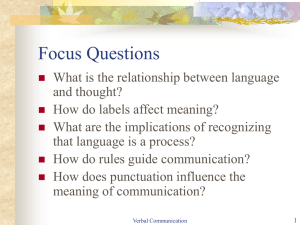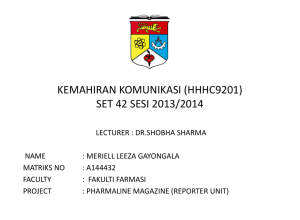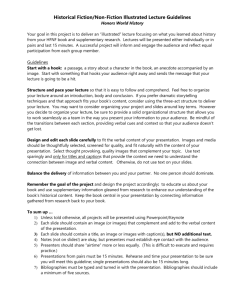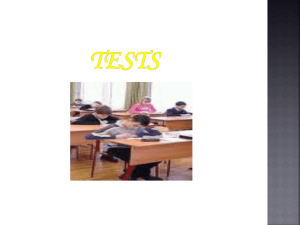1024 Slides
advertisement
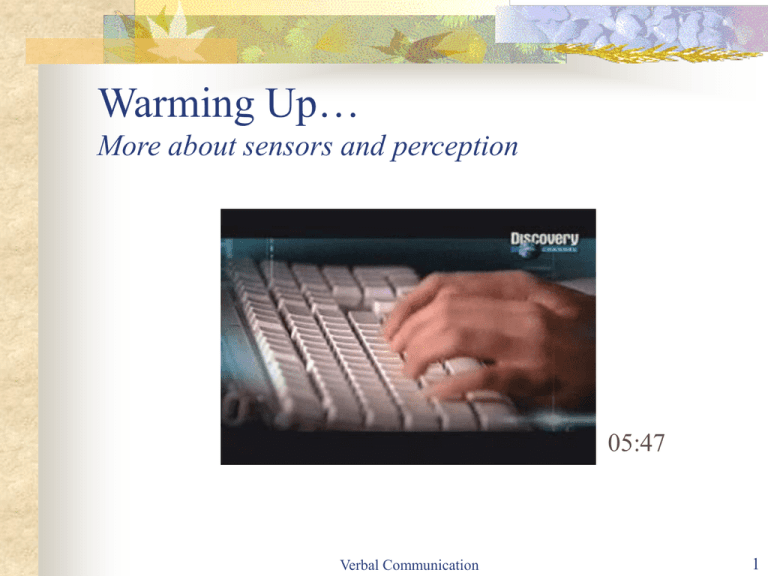
Warming Up… More about sensors and perception 05:47 Verbal Communication 1 Focus Questions What is the relationship between language and thought? How do labels affect meaning? What are the implications of recognizing that language is a process? How do rules guide communication? How does punctuation influence the meaning of communication? Verbal Communication 2 Language and Meaning Language (words) in the human world “The limits of my language are the limits of my world” by Ludwig Wittgenstein 維根斯坦 Language creates reality (or vice versa) 愛斯基摩人有30多種稱呼”雪”的命名 P.98 F.Y.I 用英文點咖啡 ; 酒、茶、海鮮… 中英文裡親屬、親戚的稱謂: Domestic partners; Birth mother; Date rape; Blended family 姑媽、姨婆、堂哥、表弟… 動畫:歐洲人 vs. 義大利人 (義大利人 算不算歐洲人?) Verbal Communication 3 Features of Language (Symbols) Arbitrary 任意性 Ambiguous 模糊性 Not intrinsically connected to what is represented; no natural relationship Commonly shared & used in a society; meaning changes over time No precise, clear-cut meanings; within a range of meaning but with degrees of uncertainty Specific to contexts, individual experience; relationships Abstract 抽象性 Not concrete or tangible Various abstractness (degrees away from external, objective phenomenon) e.g, “reading matter” 讀物 Verbal Communication 4 火星文︰中翻中 原文 明天要開56班親會,想必會來一堆歐氏宗親會的人。 morning call的成績出來了,爐主、顧爐、扛爐的還是那幾個宮本美代子的同學, 要是我考這種成 績,我媽一定AKS,罵我乾脆史努比算了。 翻譯 明天要開無聊的班親會,想必會來一堆歐吉桑和歐巴桑。 模擬考的成績出來了,倒數一二三名還是那幾個根本沒事做(台語:根本沒 代誌)的同學,要是我考 這種成績,我媽一定會氣死(台語),罵我乾脆死在路邊算了。 Verbal Communication 5 Symbols and Meaning Ladder of Abstraction (Korzybski & Hayakawa) Overgeneralization Steps away from observed phenomenon See Figure 4.1 (page 103) (also next slide) General language to describe groups of people Perceptions (recall) consistent with labels used Labels predispose selective perception (刻板印象) 外延意義Denotation vs. 內涵意義Connotation Denotation: direct, specific, explicit meaning Connotation: implied, suggested, apart from explicit meaning Verbal Communication 6 “Cow”抽象化階梯 7 6 8 Wealth: characteristics of “Bessie” are left out. Asset: all valuable things Farm assets: in common with other salable items on the farm 5 3 2 1 Livestock: referring to characteristics in common with chicken, goats.. 4 Cow: common characteristics; not peculiar to specific ones “Bessie”: the name we give to the object (cow) Cow: not the word, but the object experience Cow: consists of atoms, electronics…etc; scientific reference Verbal Communication 7 Denotation vs. Connotation “紅豆”生南國…..此物最相思 (王維) “紅豆”、大紅豆、芋頭… (阿雅) 一顆”紅豆” (鳳飛飛) “紅豆”女之戀 (韓劇) “紅豆” (王菲) “紅豆”冰 (蚊蟲/皮膚炎) • 一顆『紅蛋』 (江蕙) • 後山不可再變『深山』 (柯賜海) Verbal Communication 8 Principles of Communication Interpretation creates meaning Active, creative process of making sense Process of constructing meaning Brute facts vs. Institutional facts Brute fact: objective, concrete phenomena (e.g., huddling in football) Institutional fact: interpreted meaning of brute fact (players planning the next step) Communication is guided by rules (p. 106: task-to-do) Rule learning through socialization Regulative rules: specify when, how, where, with whom… (e.g., interruption, showing affection,..) Constitutive rules: define meaning (e.g., 加油!) Verbal Communication 9 Principles of Communication (continued) Punctuation affects meaning Marks a flow of activity into meaning units Punctuation is our perception of when interaction begins and ends. Determines initiation, interaction, invitation, participation… In personal relationships: demand-withdraw pattern (Figure 4.2, p. 108)-----no agreement on ending communication Verbal Communication 10 Six Symbolic Abilities 1. Language defines phenomena Labeling (e.g., travel fund, emergency fund) Totalizing: (e.g.,巴黎浪漫之都; 海軍陸戰隊員) 2. Language evaluates phenomena (not neutral) 3. One label represents a person totally; ignoring other aspects Spotlighting an aspect; stereotyping: describing with group characteristics Symbols are loaded with ‘value’ Loaded language (長者-老頭子) Language organizes experiences Categories that we place people (資深-受尊重?或快 被資遣了?) Verbal Communication 11 Symbolic Abilities (2) 4. Language allows hypothetical thinking Visions of the future (我的志願…) 5. Language allows self-reflection Mead (1934) I : spontaneous, creative self Me: socially conscious self 佛洛依德︰ id 本我 – unconscious & instinctive ego 自我 – between id and superego superego 超我 – of moral and social rules; ideal; perfection Verbal Communication 12 Symbolic Abilities (3) 6. Language defines relationships & interaction (職業尊稱、輩份、階級) Three dimensions of relationship-level meaning Responsiveness: question & statements (responses, feedback) Liking: When we say “I care about you.” Power: Establishing control Verbal Communication 13 Guidelines for Verbal Comm. Engage in person-centered communication Be conscious of levels of abstraction Qualify language Avoid overgeneralization Avoid static evaluation: She ‘is’ selfish Indexing technique: evaluation only applies to specific times, circumstances Own your feelings and thoughts: Claim feelings but not blame others for that You vs. I language (p. 120) (Note: Chinese cultural & syntax differences) Verbal Communication 14


